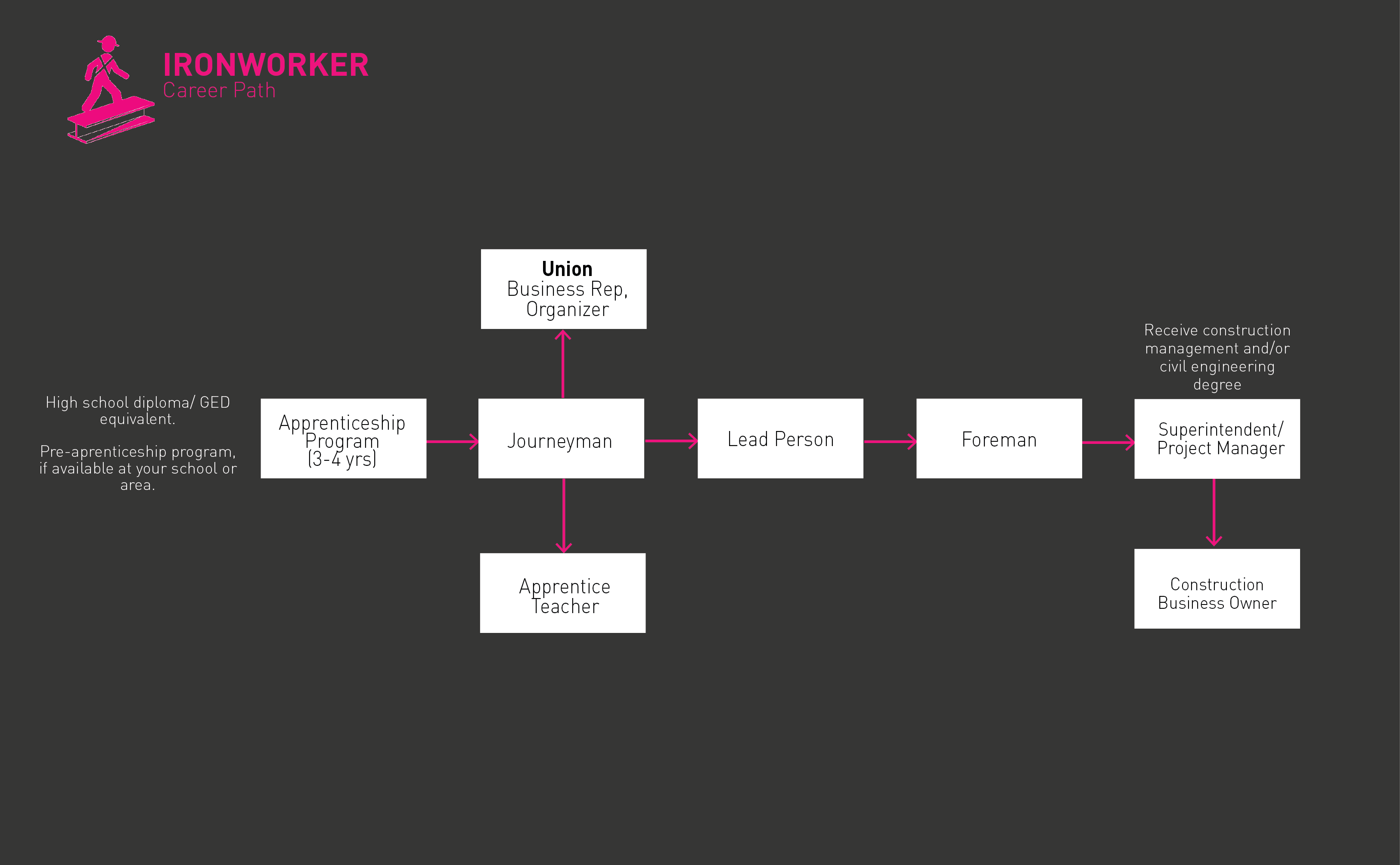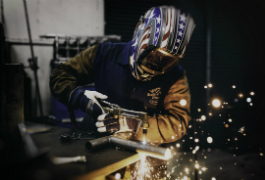Spotlights
Structural Iron and Steel Workers, Fitter, Iron Worker, Ironworker, Steel Fabricator, Steel Worker, Structural Steel Erector, Tower Hand
Ironworkers install iron or steel beams, girders, and columns to form buildings, bridges, and other structures.
- Cảm giác hoàn thành khi bạn hoàn thành một dự án
- Quyền tự trị: Bạn có thể làm việc nhiều và ít như bạn muốn.
- Thông thường bạn bắt đầu lúc 6:30 sáng-3:30 chiều: Có thể thực hiện các dự án khác vào buổi chiều.
- Làm việc với đôi tay của bạn!: "Khi bạn nghiêng về mặt máy móc, các giao dịch là tuyệt vời cho điều đó."
- Travel: If you are an international ironworker, you could do a job in another country if you want to. When you are young before you have a family and want to travel, you can work in different states and even different countries.
Ironworkers are “industrial athletes”, one of the most physical and mental jobs in the skilled trades industry.
Structural
- Unloads, erects, and connects fabricated iron beams to form the project skeleton.
- Works primarily on industrial, commercial and large residential buildings.
- Builds towers, bridges, stadiums, and prefabricated metal buildings
- Erects and installs pre-cast beams, columns and panels.
Reinforcing
- Fabricates and places steel bars (rebar) in concrete forms to reinforce structures.
- Places rebar on appropriate supports and tie them together with tie wire.
- Installs post-tensioning tendons (cables) to place in concrete forms along reinforcing steel.
- Stresses the tendons using hydraulic jacks and pumps after the concrete is poured and hardened
Ornamental
- Installs metal windows into buildings a building's masonry or wooden openings.
- Erects curtain wall and window wall systems that cover the steel or reinforced concrete structure of a building.
- Installs and erects metal stairways, catwalks, gratings, doors, railings, fencing, elevator fronts and building entrances.
Rigging and Machinery Moving
- Loads, unloads, moves and sets machinery, structural steel and curtain walls.
- Operates power hoists, cranes, derricks, forklifts and aerial lifts.
- Has knowledge of fiber line, wire rope, hoisting equipment and proper hand signals.
Welding and Burning
Welding and burning equipment are considered tools of the trade and performed by structural, reinforcing, ornamental and rigging ironworkers to secure their work to the structure. Ironworkers can be tested to be designated a certified welder.
- Manual dexterity: good with your hands.
- Phối hợp tay mắt
- Critical thinking and problem-solving: will encounter unexpected problems and you will have to figure them out in a timely fashion.
- Chú ý đến chi tiết
- Sức mạnh thể chất và sức chịu đựng
- Balance
- Unafraid of heights
- Foundation, structure and building exterior contractor
- Heavy and civil engineering contractor
- Union negotiates competitive rates: For example) In Forest Park, IL, $40.82 per hour as journeyman which is the position after you are an apprentice.
- Quyền lợi y tế đầy đủ (y tế, nha khoa, thị lực)
- Lương hưu
- Annuity
- Tiếp cận với công việc tốt hơn và cơ hội tuyệt vời
- Dangerous: Have higher-than-average risk of injury and illness. Workers may experience cuts from sharp metal edges and equipment, as well as muscle strains and other injuries from moving and guiding structural steel.
- Welding: Getting welding certification is the toughest part of being an ironworker. Takes a lot of practice.
- Downtime: When there isn’t work, you might be laid off and wait for another job. Don’t expect this to be a career where you are working the whole year. Your hourly rate is higher than most and your work is more physically demanding so you don’t need to work every day of the year to make a good living.
- Those who are certified in welding and rigging should have the best job opportunities.
- Those with prior military service are also viewed favorably during initial hiring.
- Xây dựng và sửa chữa mọi thứ! : làm việc bằng tay của bạn.
- Ở ngoài thiên nhiên.
- Thể thao
- Bất cứ thứ gì cơ khí: Làm việc trên ô tô
Welders are an important part of the industry as they use different welding processes to join two pieces of metal together. That way, they are able to create bridges, structures, small appliances, and more.
Welding doesn’t have to be a male-orientated occupation as there are many women welders that are doing a much better job than men. The welding industry currently employs about 1% of females in its welding force. But it has been able to add more than 1,200 workers in the past three years, which is a lot as opposed to the years prior.
Predictions say that by the year 2024, more than 400,000 experienced welders will retire, leaving the door for women welders wide open.
Becoming a welder is a lucrative job opportunity because it doesn’t only offer you a steady job and a chance to travel all over the world, it also sets you up for life with a very lucrative salary. Reports indicate that a median salary for an Industrial Pipeline Welder starts at $36,000 a year, while a Certified Welding Inspector can earn up to $70,000 on a yearly basis.
Women welders usually feel a great sense of accomplishment for succeeding in a primarily male-orientated field and being a role model for women and young girls that are attracted to trades.
- Bằng tốt nghiệp trung học / GED có thể cần thiết, nhưng không có yêu cầu giáo dục chính thức
- Ironworkers learn their trade as supervised apprentices over a period of up to 3 or 4 years (~144 hours of technical education plus 2,000 of paid OJT)
- A sample curriculum includes courses in:
- OSHA 10, 30, and Sub part R
- First Aid / CPR / AED
- ForkLift Training
- Scaffold Erector Dismantler
- Trained Fire Watch
- Ironworkers International Qualified Rigger / Crane Signaler
- Architectural Ornamental
- Đọc bản thiết kế
- C.O.M.E.T. - Construction Organizing Membership Education Training
- Foreman Training
- Layout Instrumentation
- Reinforcing Concrete
- Rigging and Cranes
- Structural Steel Erection
- Hàn
- Học nghề là một cách học tập lâu đời bằng cách làm. Hầu hết được tài trợ bởi các hiệp hội công đoàn và nhà thầu (xem Tài nguyên > Trang web được Đề xuất của chúng tôi để biết chi tiết)
- Technical instruction covers proper tool and equipment usage, installation techniques, safety, first aid, blueprint reading, and general construction
- Occupational Safety and Health Administration safety training is also required
- Các chương trình chứng nhận tùy chọn bao gồm:
- American Welding Society welding certifications
- National Commission for the Certification of Crane Operators - Rigger Level I and II
- National Center for Construction Education and Research - Rigger & Signal Person Certification
- International Code Council - Structural Welding Special Inspector; Structural Steel and Bolting Special Inspector
Các công đoàn và nhà thầu tài trợ cho các chương trình học nghề. Các bằng cấp cơ bản để tham gia chương trình học nghề như sau:
- Độ tuổi tối thiểu là 18
- Bằng lái xe
- Bằng tốt nghiệp trung học phổ thông hoặc tương đương (GED hoặc làm bài kiểm tra năng khiếu)
- Thể chất có thể thực hiện công việc
- Pass substance abuse screening
Bấm vào đây để xem danh sách các chương trình.
- Take courses in high school such as shop, welding, and math
- Start an exercise routine to build strength, stamina, and balance so you can work safely
- Working with iron, sometimes at elevated heights in outdoor conditions, can be very dangerous! Get in the habit of practicing outstanding safety at all times
- Tìm hiểu cách sử dụng và mặc thiết bị bảo vệ cá nhân phù hợp
- Lấy bằng lái xe của bạn để bạn có thể đến các trang web việc làm đúng giờ
- Learn as much as you can on your own about Ironwork. Study books, articles, and video tutorials related to the glass installation
- Tình nguyện cho các dự án để có được kinh nghiệm thực tế
- Được chứng nhận trong một lĩnh vực chuyên biệt để củng cố thông tin đăng nhập của bạn

- Take pre-apprenticeship classes (gladiator classes) and contractors will come down and watch the people work and start drawing them from that group (like “tryouts”). Doing well in pre-apprenticeship classes almost guarantees you into the apprenticeship program.
- Hoàn thành chương trình học nghề (lưu ý: bạn đang làm việc với tiền lương trong khi bạn là người học việc)
- Công đoàn sẽ cung cấp cho bạn danh sách người ký: công đoàn địa phương sẽ cung cấp cho bạn một số khách hàng tiềm năng, bạn bắt đầu thực hiện cuộc gọi đến các nhà thầu trong danh sách.
- Liên hệ với Job Corps
- Ask the local union for help: Get on the “out of work” list.
- Apprenticeships are the best way to get started
Check out sites like Apprenticeship.gov, CareerOneStop, Department of Labor Employment and Training Administration, and Helmets to Hardhats for info on opportunities - Nếu tham gia các lớp học tại một trường thương mại hoặc dạy nghề, hãy yêu cầu trung tâm hướng nghiệp của họ để được hỗ trợ
- If you served in the military, check out CareerOneStop or state websites for details on unique Veteran opportunities
- Let potential employers know you plan to stick through the long apprenticeship process
- Công cụ ước tính: Lập ngân sách cho công việc sau đó đấu thầu cho công việc.
- Quản lý dự án: Đằng sau hậu trường, thủ tục giấy tờ. Đảm bảo yêu cầu thông tin được điền. Tiền đang được trả. Làm việc kết hợp với Giám đốc.
- Giám đốc: Chăm sóc nhu cầu nhân lực tại nơi làm việc. Vật liệu và công nhân.
- Quản đốc: Chăm sóc công việc.
- Người dẫn dắt: Cánh tay phải của quản đốc.
- Personally motivated to learn skills and master the trade
- “They leave it all on the job site.”
- Physically and mentally sharp
- Good with people
- Dedication
- Người giỏi nhất với các công cụ và công đoàn nâng cao những người này.
- Lãnh đạo / Giáo viên: một người biết rất rõ về nghề và họ dạy người khác.
Các trang web
- Hiệp hội hàn Hoa Kỳ
- Apprenticeship.gov
- Các nhà xây dựng và nhà thầu liên kết
- Tổng thầu liên kết của Mỹ
- CareerOneStop
- Cục Quản lý việc làm và đào tạo lao động
- Mũ bảo hiểm đến Hardhats
- International Association of Bridge, Structural, Ornamental and Reinforcing Iron Workers
- Trung tâm Nghiên cứu và Giáo dục Xây dựng Quốc gia
- National Commission for the Certification of Crane Operators
Sách vở
Alternate careers: Boilermakers, Carpenters, Welders
"The most helpful thing to say to someone thinking of being an ironworker is just to try it out. If anyone feels any proclivity to such work they should give it a go.
After some short time, they will know if that is a career for them or not. People that love working with metal will fall in love with it as soon as they spend some time in a shop or on site. On top of that is to never stop improving and finding more ways to love your work. This is a tough profession and after many years of day in and day out work you will eventually wear out. The secret is to constantly be trying new things and branching out. If you weld MIG for many years then you could start learning TIG which is a very different game. If you are working in fabrication for too long and it becomes monotonous then you could try construction. That way you learn new things, meet new people, exchange experiences and forge your own path that may lead you to who knows where but wherever it does, it will be a place where only those with experience and love for their work can get to." Adam Mason, Welding Pros
Nguồn cấp tin tức

Công việc nổi bật

Các khóa học và công cụ trực tuyến

Kỳ vọng về mức lương hàng năm
New workers start around $60K. Median pay is $101K per year. Highly experienced workers can earn around $108K.
Kỳ vọng về mức lương hàng năm
New workers start around $53K. Median pay is $75K per year. Highly experienced workers can earn around $101K.








